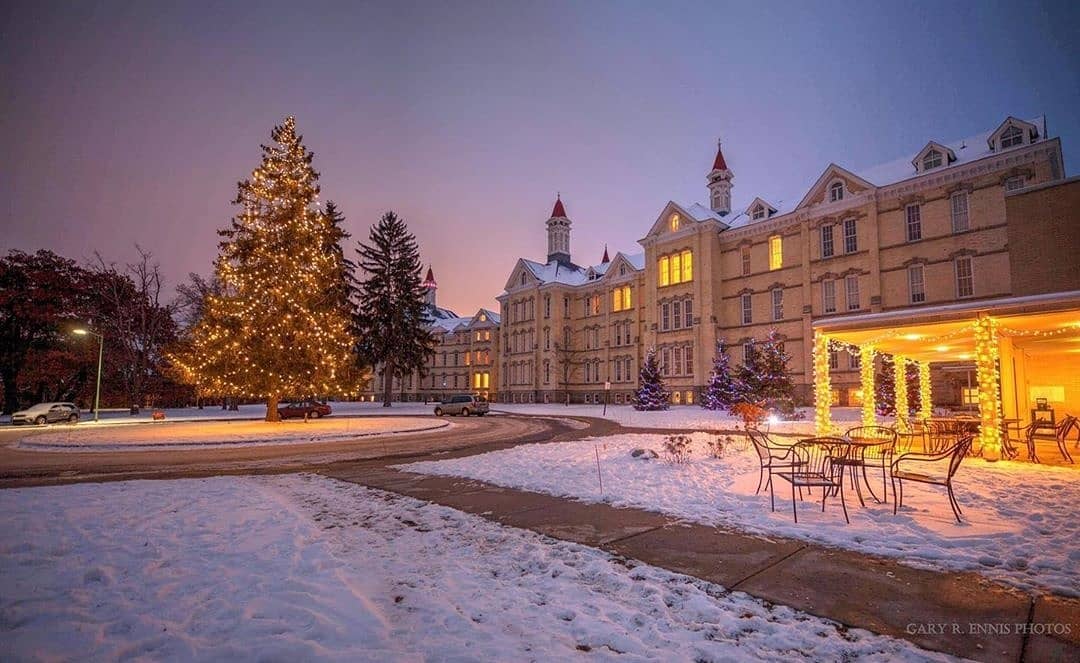Explore Traverse City History at These Iconic Sites

Traverse City's history is fascinating. Reminders of its brief but dramatic past are scattered everywhere: lonely lighthouses, humble mission churches, workingmen’s taverns, quaint Victorian cottages and the grand estates of 19th century lumber barons. Fortunately, you can visit and tour many of these sites.
Eyaawing Museum & Cultural Center
Indian hunters and French traders were the first people to visit this place, and it was they who gave the region its name – La Grand Traverse – because of the “long crossing” they had to make by canoe across the mouth of the bay. But they were just passing through; even the native Ottawa and Chippewa people didn’t arrive as settlers until the early 18th century.
To learn more about those earliest arrivals, who call themselves simply Anishinaabek (“The People”) – take a drive up the Leelanau Peninsula to Peshawbestown, the headquarters of the 5,000-member Grand Traverse Band of Ottawa and Chippewa Indians to visit the Eyaawing Museum & Cultural Center, which contains exhibit galleries and a store featuring traditional and contemporary artworks.
Mission Point Lighthouse
It wasn’t until 1839 that the Rev. Peter Dougherty established the area’s first permanent settlement at the tip of the Old Mission peninsula. The modern-day village of Old Mission still occupies Dougherty’s idyllic site: a place seemingly frozen in time, where many of the original structures are still standing and in use. Three miles to the north is the quaint Mission Point Lighthouse, built in 1870 to warn ships away from the rocky shoals of Old Mission Point.
Perry Hannah House
By 1847 a small but growing community was forming on the banks of the nearby Boardman River. In 1852 the little sawmill town was christened Traverse City -- but until the first road through the forest was built in 1864 it remained a remote outpost, accessible only by water. A good place to begin exploring this community’s beginnings is on Sixth Street in the city’s historic Central Neighborhood. Start at the immense 32-room Perry Hannah House, built by Traverse City founder Perry Hannah in 1893. It’s a true showcase, with its beveled Tiffany doors, copper-clad turrets and intricate wood paneling. (A different wood was used in almost every room -- appropriately enough for a man whose fortune came from the forest.)
The Big Store
A few blocks to the north is Front Street, Downtown Traverse City’s main street, and the immense white building that once housed the heart of Hannah’s 19th century Empire. Built in 1863, when it was known as The Big Store, it’s only half as large as it used to be – it once stretched for two blocks.
City Opera House
After decades of neglect, Front Street has been extensively restored and is now a picturesque and pedestrian-friendly reminder of the city’s historical roots. Its tree-shaded sidewalks now border shops, restaurants and galleries that have made creative use of the Victorian buildings they occupy. One special landmark is the ornate 1891 City Opera House.
Sleder’s Family Tavern
Not everyone in 19th-century Traverse City was a millionaire. The city’s west side, known as Slabtown, was home to millworkers and skilled woodcarvers, including a substantial community of Bohemian immigrants who built tidy cottages for themselves with slabs of scrapwood from the sawmills. Many of their homes are still standing, and so is Sleder’s Family Tavern, a 136 year-old establishment that’s still a favorite hangout for locals and visitors alike.
Village at Grand Traverse Commons

After the lumber boom ended, the local economy turned to manufacturing and agriculture – potatoes, apples, and eventually cherries. But the city’s biggest economic windfall came in 1885, when it was designated as the site of the Northern Michigan Asylum, which became one of the city’s major employers and eventually housed a population several times larger than that of the town itself.
Today, the 480-acre site of the former hospital is known as the Village at Grand Traverse Commons and has been redeveloped into a unique “village” of shops, restaurants, apartments and galleries. Developers are preserving both the castle-like Italianate century buildings that once housed staff and patients, while its lovely wooded campus has become a favorite place for hikers and cyclists.
History isn’t just about big public buildings; some of this town’s most charming reminders of the past are in its lovingly-restored old homes and neighborhoods, which are wonderful places for a stroll or a bicycle ride!